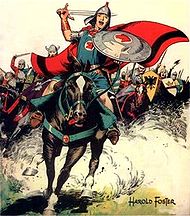|
|||
|
Philatelia.Net / Pirates. Bandits. Adventurers / Plots / The directory «Plots»Prince ValiantPrince Valiant in the Days of King Arthur, or simply Prince Valiant, is a comic strip created by Hal Foster. It is an epic adventure that has told a continuous story for its entire history. Today it stands out for its realistic panoramas and intelligent and often humorous narrative, which appears below the pictures, without word balloons. The events shown are historically accurate, but taken from various different time periods ranging from the late Roman Empire to the High Middle Ages, with a few very brief scenes from more modern times commenting on the "manuscript". Prince Valiant began in full color tabloid sections on Saturday February 13, 1937. The first full page was strip #16, which appeared in the Sunday New Orleans Times Picayune. The internal dating changed from Saturday to Sunday with strip #66 (May 15, 1938). The full page strip continued until 1971 when strip #1788 was not offered in full page format—it was the last strip Hal Foster drew. The strip continues today by other artists in half page format. The setting is Arthurian. Valiant himself is a Nordic prince (from the faraway Thule—apparently located somewhere near the city Trondheim on the Norwegian west coast). Early in the story, Valiant comes to Camelot, becomes fast friends with Sir Gawain and Sir Tristram, earns the respect of King Arthur and Merlin, and becomes a Knight of the Round Table. Later, he meets the love of his life—Aleta—on a Mediterranean island. He fights the Huns with his magic Singing Sword, Flamberge, travels to Africa and to America, and helps his father regain his lost throne of Thule, usurped by the tyrant Sligon. The historical and mythological elements of Prince Valiant were initially chaotic, but soon Foster attempted to bring the facts into order. Some of the elements of the story (for instance, the death of Attila the Hun in 453, the murder of Aëtius in 454, though different from the historical version (Valiant and Gawain are blamed for the murder and must flee), and Geiseric's sacking of Rome in 455, which Prince Valiant and Aleta witness), place the story in the 5th century. Some slightly fantastic elements, like "marsh monsters" (a dinosaur-like creature) and witches, are present in the early years but are later downplayed (as are Merlin's and Morgan le Fay's use of magic), so that by 1942 the story is in most aspects a realistic one. Still, the storyline is far from being historically accurate; while obviously meant to take place in the mid 5th century, Foster continuously incorporated "out-of-era" features: Viking Longships, Muslims, alchemist and technological advances not made before the Renaissance, and the fortifications, armor and armament resemble the High Middle Ages. In 1970, after try-out strips by several artists, Foster invited John Cullen Murphy to collaborate on the strip. Here is a list of the transition artists: From 1971 on, Murphy drew the strip from Foster scripts and pencil sketches. Foster continued to write the strip until strip #2241 in 1980. Murphy then drew it himself, with scripts by his son Cullen Murphy, an editor of The Atlantic Monthly. Stories by Cullen Murphy included many adventures in which Val is opposed by Byzantine Emperor Justinian. John Cullen Murphy's daughter, Mairead, did the lettering and coloring. In March 2004, Murphy retired, and turned the strip over to his hand-picked successor, illustrator Gary Gianni. Writing duties were soon afterwards passed on to Mark Schultz. Coloring is handled by Scott Roberts. Prince Valiant appears weekly in more than three hundred newspapers nationwide, according to its distributor, King Features Syndicate. The full stretch of the story is now over 3700 Sunday strips. Marvel Comics published a 4-part miniseries titled Prince Valiant in the 1990s. Belgium, 2003, The Brave Knight USA, 1995, Prince Valiant Advertising: |
|||
© 2003-2024 Dmitry Karasyuk. Idea, preparation, drawing up
|

